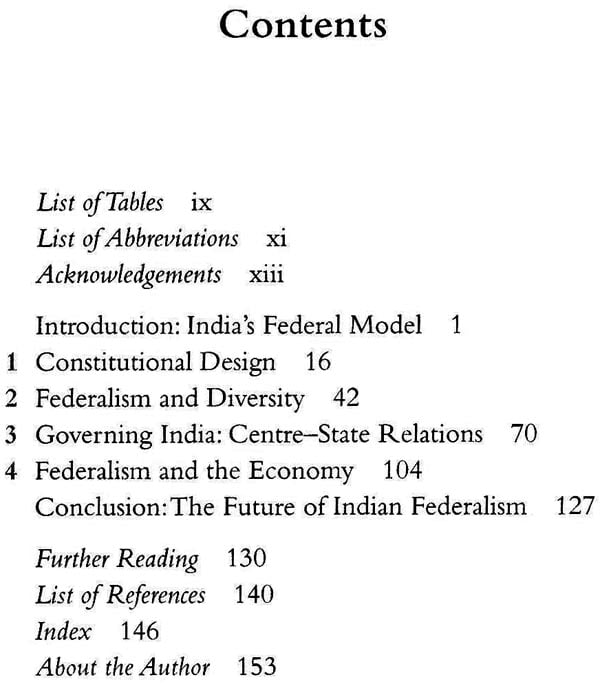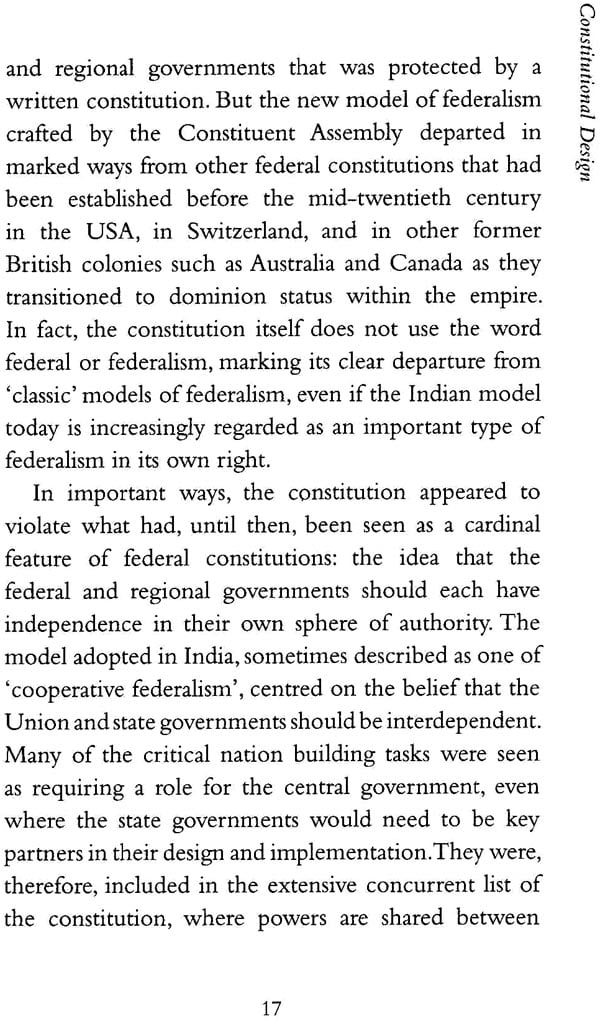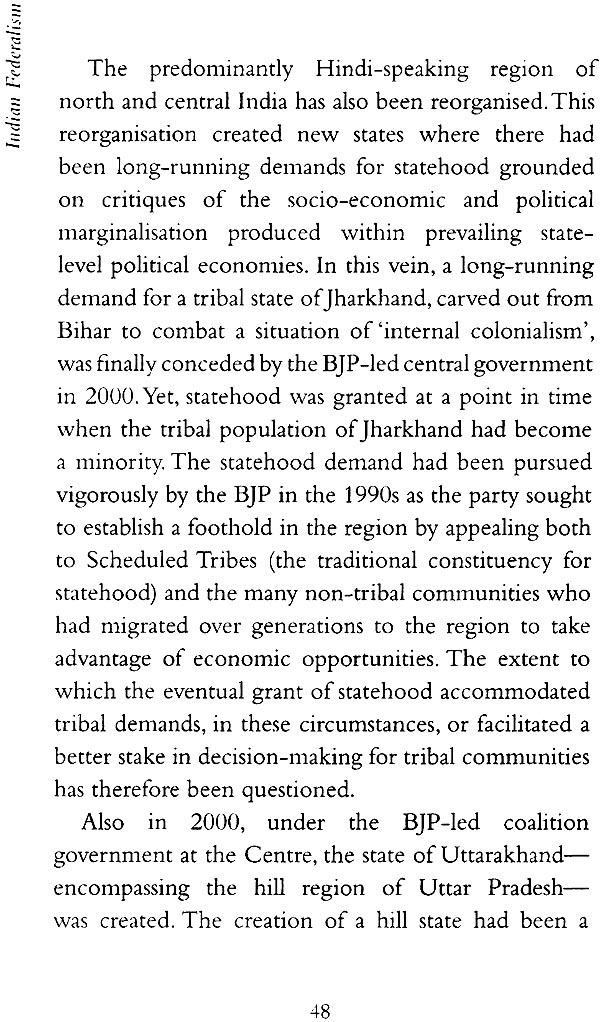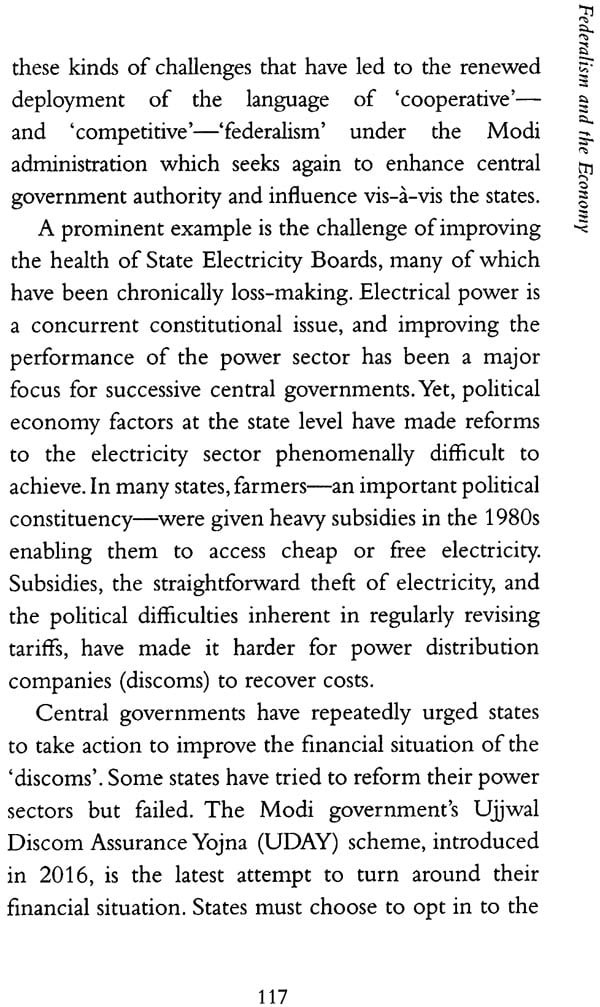
Oxford India Short Introductions - Indian Federalism
Book Specification
| Item Code: | NAR969 |
| Author: | Louise Tillin |
| Publisher: | Oxford University Press |
| Language: | English |
| Edition: | 2019 |
| ISBN: | 9780199495610 |
| Pages: | 168 |
| Cover: | PAPERBACK |
| Other Details | 7.50 X 5.00 inch |
| Weight | 150 gm |
Book Description
To understand how politics, the economy, and public policy function in the world’s largest democracy, an appreciation of federalism is essential. Bringing to surface the complex dimensions that affect relations between India’s central government and states, this short introduction is the one-stop account to federalism in India.
Paying attention to the constitutional, political, and economic factors that shape Centre-state relations, this book stimulates understanding of some of the big dilemmas facing India today. The ability of India’s central government to set the economic agenda or secure implementation of national policies throughout the country depends on the institutions and practices of federalism. Similarly, the ability of India’s states to contribute to national policy making or to define their own policy agendas that speak to local priorities hinges on questions of federalism.
Organised in four chapters, this book introduces readers to one of the key living features of Indian democracy.
Louise Tillin is reader in politics at King's India Institute, King’s College London, UK. She is an editor of Regional and Federal Studies, a leading journal on federalism and territorial politics across the world.
Federalism rests on an idea of shared and multi-layered sovereignty enshrined within a particular configuration of political institutions. In federal systems, at least two levels of government—in India’s case, the Centre and the states—share in the task of governing but have their own spheres of autonomy. Their joint and individual roles are typically protected by a written constitution, with a Supreme Court serving as an umpire in case of disputes.
Federalism has enabled the expression and protection of diverse forms of belonging within India and has been central to the richness and resilience of India’s democracy. It is difficult to imagine a country of India’s scale and societal diversity being governed without compromises over the sharing of decision-making rights and administrative responsibilities amongst tiers of government at the all-India and regional levels. Yet, some of the biggest dilemmas facing India today arise from the complexities and ambiguities generated within the resulting federal order.
In order to get to the bottom of how policies are made and the impacts they have in India’s complex multi-level political and economic ecosystem, an appreciation of federalism is essential. The ability of the central government to promote economic dynamism or reduce inequality between regions, or the ability of India’s states to define and resource their own policy agendas that speak to local needs and priorities, is shaped by federal institutions and practice. Questions such as how to achieve a balance between regional political, fiscal, and administrative autonomy, and the scope for authoritative policy making by the central government are some of the thorniest issues facing India today.
India’s model of federalism reflects the circumstances in which it was created in the aftermath of Partition and in an era when the need for strong central governments able to steer national development plans was influencing the design and reform of federal systems in other countries.
The heavily centralised order that India’s constitutional architects opted for in the aftermath of the partition of the subcontinent departed radically from earlier visions of a decentralised federal model for India in which the central government’s role would have been restricted to a small number of nationwide subjects and provinces empowered. India designed a federal system in order to share power with provinces. But strong measures were put in place to maintain the authority of the central government, and to allow for the operation of more unitary powers in times of emergency. Reflecting this, the word federalism does not appear by name in the constitutional text. As Dr B.R. Ambedkar said on introducing the draft constitution to the Constituent Assembly, the constitution was federal to the extent it introduced a ‘dual polity’ in which the Centre and the states each have sovereign powers exercised in fields established by the constitution. But the flexibility inherent in the Indian constitution distinguished the proposed Indian model of federalism from all that had gone before:
All federal systems including the American are placed in a tight mould of federalism. No matter what the circumstances, it cannot change its form and shape.
It can never be unitary. On the other hand ... [India’s] Draft Constitution can be both unitary as well as federal according to the requirements of time and circumstances. In normal times, it is framed to work as a federal system. But in times of war it is so designed as to make it work as though it was a unitary system.... Such a power of converting itself into a unitary State no federation possesses. This is one point of difference between the Federation proposed in the Draft Constitution, and all other Federations we know of. (Ambedkar 1948)
The Constituent Assembly had designed a model to enable the central government to act fast with relatively few checks in instances where internal or external crises threatened stability. The constitution also enshrined a model of strong interdependence between the central government and states that was intended to push both levels of government to work together to resolve issues of national importance.
**Contents and Sample Pages**












